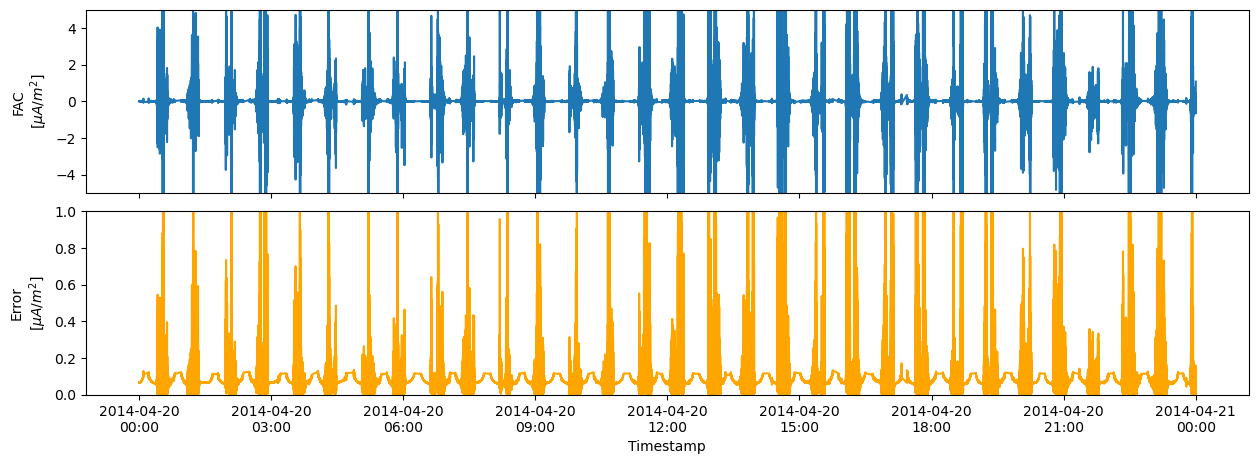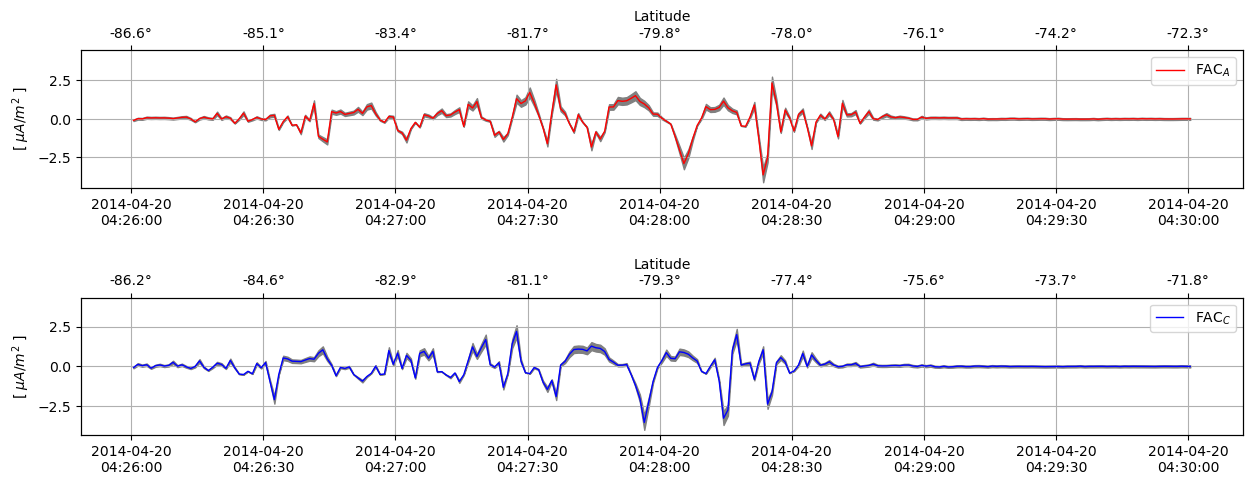FACxTMS_2F (single spacecraft)#
Abstract: Access to the field aligned currents evaluated by the single satellite method (level 2 product). We show simple line plots of the time series over short periods (minutes), from both Swarm Alpha and Charlie. We also compare with the alternative method whereby the FACs are evaluated locally by computing them from the magnetic field data (
B_NECfromMAGx_LR_1B).
Documentation:
%load_ext watermark
%watermark -i -v -p viresclient,pandas,xarray,matplotlib
Python implementation: CPython
Python version : 3.11.6
IPython version : 8.18.0
viresclient: 0.12.3
pandas : 2.1.3
xarray : 2023.12.0
matplotlib : 3.8.2
from viresclient import SwarmRequest
import datetime as dt
import numpy as np
import pandas as pd
import matplotlib.pyplot as plt
import matplotlib.dates as mdates
import cartopy.crs as ccrs
import cartopy.feature as cfeature
request = SwarmRequest()
Check what “FAC” data variables are available#
NB: these are the same as in the FAC_TMS_2F dual-satellite FAC product
request.available_collections("FAC", details=False)
{'FAC': ['SW_OPER_FACATMS_2F',
'SW_OPER_FACBTMS_2F',
'SW_OPER_FACCTMS_2F',
'SW_OPER_FAC_TMS_2F',
'SW_FAST_FACATMS_2F',
'SW_FAST_FACBTMS_2F',
'SW_FAST_FACCTMS_2F']}
request.available_measurements("FAC")
['IRC',
'IRC_Error',
'FAC',
'FAC_Error',
'Flags',
'Flags_F',
'Flags_B',
'Flags_q']
Plotting as a time series#
Fetch one day from Swarm Alpha and Charlie#
Also fetch the quasidipole (QD) coordinates and Orbit Number at the same time.
request.set_collection("SW_OPER_FACATMS_2F", "SW_OPER_FACCTMS_2F")
request.set_products(
measurements=["FAC", "FAC_Error",
"Flags", "Flags_F", "Flags_B", "Flags_q"],
auxiliaries=["QDLat", "QDLon", "OrbitNumber"],
)
data = request.get_between(
dt.datetime(2014,4,20),
dt.datetime(2014,4,21)
)
The source files of the original data are listed
data.sources
['SW_OPER_AUXAORBCNT_20131122T132146_20250622T234324_0001',
'SW_OPER_AUXCORBCNT_20131122T132146_20250622T234316_0001',
'SW_OPER_FACATMS_2F_20140420T000000_20140420T235959_0401',
'SW_OPER_FACCTMS_2F_20140420T000000_20140420T235959_0401']
The data can be loaded as a pandas dataframe
df = data.as_dataframe()
df = df.sort_index()
df.head()
| FAC | QDLon | OrbitNumber | Longitude | Latitude | Spacecraft | Radius | FAC_Error | QDLat | Flags_F | Flags_B | Flags | Flags_q | |
|---|---|---|---|---|---|---|---|---|---|---|---|---|---|
| Timestamp | |||||||||||||
| 2014-04-20 00:00:00.500 | 0.004292 | 87.677834 | 2267 | 19.102806 | -26.849185 | A | 6851356.835 | 0.065509 | -36.222500 | 2 | 0 | 0 | 0 |
| 2014-04-20 00:00:00.500 | -0.020003 | 89.366638 | 2263 | 20.535146 | -26.285007 | C | 6851317.060 | 0.062153 | -35.770004 | 2 | 0 | 0 | 0 |
| 2014-04-20 00:00:01.500 | 0.003943 | 89.390350 | 2263 | 20.534623 | -26.221325 | C | 6851310.440 | 0.065763 | -35.718651 | 2 | 0 | 0 | 0 |
| 2014-04-20 00:00:01.500 | 0.006710 | 87.701981 | 2267 | 19.102319 | -26.785506 | A | 6851350.325 | 0.065887 | -36.172028 | 2 | 0 | 0 | 0 |
| 2014-04-20 00:00:02.500 | 0.010963 | 87.726082 | 2267 | 19.101828 | -26.721826 | A | 6851343.805 | 0.066541 | -36.121506 | 2 | 0 | 0 | 0 |
Alternatively we can load the data as an xarray Dataset, though in the following examples we use the data via a pandas DataFrame instead
ds = data.as_xarray()
ds
<xarray.Dataset>
Dimensions: (Timestamp: 172800)
Coordinates:
* Timestamp (Timestamp) datetime64[ns] 2014-04-20T00:00:00.500000 ... 20...
Data variables: (12/13)
Spacecraft (Timestamp) object 'A' 'A' 'A' 'A' 'A' ... 'C' 'C' 'C' 'C' 'C'
FAC (Timestamp) float64 0.004292 0.00671 ... 0.09216 0.01805
OrbitNumber (Timestamp) int32 2267 2267 2267 2267 ... 2279 2279 2279 2279
Longitude (Timestamp) float64 19.1 19.1 19.1 19.1 ... 100.6 102.0 103.3
Flags_q (Timestamp) uint32 0 0 0 0 0 0 0 0 0 0 ... 0 0 0 0 0 0 0 0 0 0
Latitude (Timestamp) float64 -26.85 -26.79 -26.72 ... 87.31 87.33 87.33
... ...
FAC_Error (Timestamp) float64 0.06551 0.06589 0.06654 ... 0.04353 0.05464
QDLat (Timestamp) float64 -36.22 -36.17 -36.12 ... 81.26 81.27 81.28
Flags_F (Timestamp) uint32 2 2 2 2 2 2 2 2 2 2 ... 2 2 2 2 2 2 2 2 2 2
Flags_B (Timestamp) uint32 0 0 0 0 0 0 0 0 0 0 ... 0 0 0 0 0 0 0 0 0 0
Flags (Timestamp) uint32 0 0 0 0 0 0 0 0 0 0 ... 0 0 0 0 0 0 0 0 0 0
QDLon (Timestamp) float64 87.68 87.7 87.73 ... 171.9 172.4 172.8
Attributes:
Sources: ['SW_OPER_AUXAORBCNT_20131122T132146_20250622T234324_000...
MagneticModels: []
AppliedFilters: []Depending on your application, you should probably do some filtering according to each of the flags. This can be done on the dataframe here, or beforehand on the server using request.set_range_filter(). See https://earth.esa.int/documents/10174/1514862/Swarm_L2_FAC_single_product_description for more about the data
Plot the time series (FAC and FAC_Error for Alpha)#
fig, axes = plt.subplots(ncols=1, nrows=2, figsize=(15,5))
# Select out the time series from Swarm Alpha
dfA = df.where(df["Spacecraft"] == "A").dropna()
axes[0].plot(dfA.index, dfA["FAC"])
axes[1].plot(dfA.index, dfA["FAC_Error"], color="orange")
axes[0].set_ylabel("FAC\n[$\mu A / m^2$]");
axes[1].set_ylabel("Error\n[$\mu A / m^2$]");
axes[1].set_xlabel("Timestamp");
date_format = mdates.DateFormatter('%Y-%m-%d\n%H:%M')
axes[1].xaxis.set_major_formatter(date_format)
axes[0].set_ylim(-5, 5);
axes[1].set_ylim(0, 1);
axes[0].set_xticklabels([])
fig.subplots_adjust(hspace=0.1)

Plot a subset of the time series (FAC from Alpha and Charlie)#
def line_plot(fig, ax, df, varname="FAC", spacecraft="A", color="red"):
"""Plot FAC as a line, given a dataframe"""
df = df.copy()
df = df.where(df["Spacecraft"] == spacecraft).dropna()
ax.plot(df.index, df[varname], linewidth=1,
label=f"{varname}$_{spacecraft}$", color=color)
# Plot error range as filled area
if varname == "FAC":
ax.fill_between(df.index,
df["FAC"] - df["FAC_Error"],
df["FAC"] + df["FAC_Error"], color="grey")
# Adjust limits and label formatting
datetime_format = "%Y-%m-%d\n%H:%M:%S"
xlabel_format = mdates.DateFormatter(datetime_format)
ax.xaxis.set_major_formatter(xlabel_format)
ax.set_ylabel("[ $\mu A / m^2$ ]")
# Make y-axis symmetric about zero
ylim = max(abs(y) for y in ax.get_ylim())
ax.set_ylim((-ylim, ylim))
ax.legend()
ax.grid(True)
# Set up an extra xaxis at the top, to display Latitude
ax2 = ax.twiny()
ax2.set_xlim(ax.get_xlim())
ax2.set_xticks(ax.get_xticks())
# Identify closest times in dataframe to use for Latitude labels
# NB need to draw the figure now in order to get the xticklabels
# https://stackoverflow.com/a/41124884
fig.canvas.draw()
# Extract times from the lower x axis
# Use them to find the nearest Lat values in the dataframe
xtick_times = [dt.datetime.strptime(ts.get_text(), datetime_format) for ts in ax.get_xticklabels()]
ilocs = [df.index.get_indexer([t], method="nearest")[0] for t in xtick_times]
lats = df.iloc[ilocs]["Latitude"]
lat_labels = ["{}°".format(s) for s in np.round(lats.values, decimals=1)]
ax2.set_xticklabels(lat_labels)
ax2.set_xlabel("Latitude")
# Easy pandas-style slicing of the dataframe
df_subset = df['2014-04-20T04:26:00':'2014-04-20T04:30:00']
fig, axes = plt.subplots(nrows=2, figsize=(15, 5))
line_plot(fig, axes[0], df_subset, spacecraft="A", color="red")
line_plot(fig, axes[1], df_subset, spacecraft="C", color="blue")
fig.subplots_adjust(hspace=0.8)

FAC estimates from (top) Swarm Alpha and (bottom) Swarm Charlie. The error estimate is shown as a thin grey area
Also show satellite location on a map#
def line_plot_figure(df, spacecraft="A", color="red"):
"""Generate a figure containing both line plot and maps"""
df = df.copy()
df = df.where(df["Spacecraft"] == spacecraft).dropna()
# Set up figure geometry together with North/South maps
fig = plt.figure(figsize=(20, 5))
ax_lineplot = plt.subplot2grid((1, 5), (0, 0), colspan=3, fig=fig)
ax_N = plt.subplot2grid((1, 5), (0, 3), fig=fig,
projection=ccrs.Orthographic(
central_longitude=0.0, central_latitude=90.0
))
ax_S = plt.subplot2grid((1, 5), (0, 4), fig=fig,
projection=ccrs.Orthographic(
central_longitude=0.0, central_latitude=-90.0
))
for _ax in (ax_N, ax_S):
_ax.set_global()
_ax.coastlines(color="grey")
_ax.add_feature(cfeature.LAND)
_ax.add_feature(cfeature.OCEAN)
_ax.plot(df["Longitude"], df["Latitude"], transform=ccrs.PlateCarree(),
linewidth=4, color=color)
# Draw the line plot as before
line_plot(fig, ax_lineplot, df, spacecraft=spacecraft, color=color)
line_plot_figure(df_subset, spacecraft="A", color="red")
/opt/conda/lib/python3.11/site-packages/cartopy/io/__init__.py:241: DownloadWarning: Downloading: https://naturalearth.s3.amazonaws.com/110m_physical/ne_110m_land.zip
warnings.warn(f'Downloading: {url}', DownloadWarning)
/opt/conda/lib/python3.11/site-packages/cartopy/io/__init__.py:241: DownloadWarning: Downloading: https://naturalearth.s3.amazonaws.com/110m_physical/ne_110m_ocean.zip
warnings.warn(f'Downloading: {url}', DownloadWarning)
/opt/conda/lib/python3.11/site-packages/cartopy/io/__init__.py:241: DownloadWarning: Downloading: https://naturalearth.s3.amazonaws.com/110m_physical/ne_110m_coastline.zip
warnings.warn(f'Downloading: {url}', DownloadWarning)

